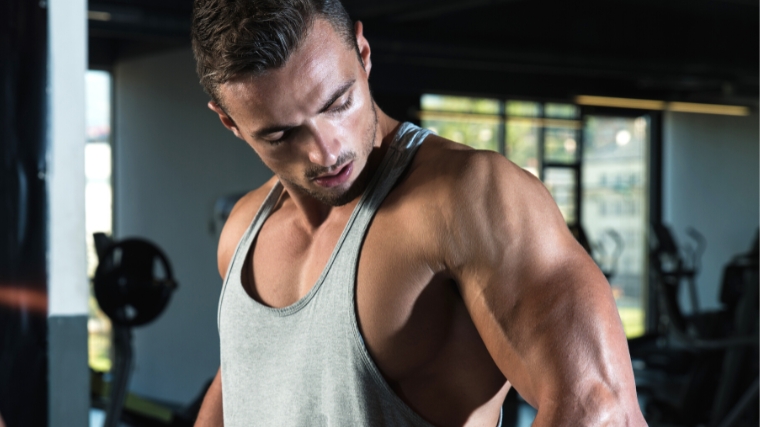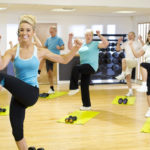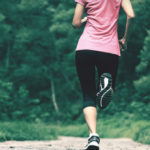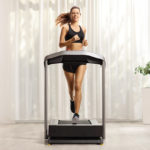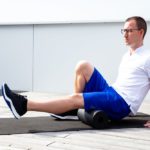If you ask 1,000 random weightlifters if they want more muscled arms, very few will say “no”. The biceps is one of the most visible parts of the body and a set that looks impressive will make people’s heads spin.
There are many other benefits of biceps exercises, beyond adding a few slabs to your arms. These include improved shoulder stability and joint health. (1) Heck, it could be used to lose fat and maintain lean muscle mass while cutting calories.
Credit: Ruslan Shugushev / Shutterstock
Most people think of biceps exercises as an afterthought, either after working out a bigger body part such as their back or chest. Or they do them as part of an arms-only workout consisting of mostly single-joint exercises (isolation).
If you are creative and smart, or you have little to no equipment available, you can still give your body a great workout that is both effective and refreshing. Try these weightless workouts if you’re not a member of a gym or are on vacation.
Best Biceps Exercises
Exercises that only use your bodyweight to build biceps
Exercise Resistance Bands for Biceps
Best Biceps Workout Using Only Bodyweight
It’s a way to get back to the basics of training, which is to be able to control your body. Try this workout if you are tired of weight lifting and want to reconnect with your primal side. You should not limit yourself to only single-joint exercises (isolation), because your biceps is involved in many other movements than just arm flexion.
Credit: Blanscape / Shutterstock
This workout combines multi-joint movements with isolation exercises to target the biceps. This workout will provide the best stimulation for muscle growth and fat loss, while covering all the functions of this muscle. Multi-joint exercise is better for the body’s strength adaptations, and also to burn calories, whereas single-joint workouts are great for improving your mind-muscle relationship or bringing up a particular weak point.
The No-Weight Exercise
This workout should be performed once a week after warming up for best results. You’ll need to find other ways to progress since you cannot increase the weight. Once you are able to comfortably complete the desired number of repetitions in each set, move up the weight range. If an exercise requires 12-15 reps, you could try increasing the number of repetitions to 15 once you have completed all your sets. You can then add another set. You can reduce the rest period gradually.
Commando Chin-Up
Position yourself underneath a pull-up and grasp it with both hands together and your thumbs facing inward. Hold yourself still and tighten your core for stability. You can start the exercise by pulling your shoulder blades downwards. Bend your elbows and lift yourself up towards the barbell. Aim your head to the left.
Aim to touch it with your right shoulder. Return to your starting position by lowering yourself with control. Repeat, but this time with the head pointing to the right side of bar. Repeat the reps until you reach your desired number. Switch hands for the next set so that the person closest to you is now at the furthest end of the bar.
Sets and Reps : 4 x 4- 8
Rest time: Three minutes between sets.
Headbanger Chin-Up
Grab the bar with a supinated grip that is about shoulder width (palms towards you). As you pull up, brace your core and pack your shoulder blades down and together.
Hold this position and begin moving your body away and towards the bar. Extend and flex the arms. It should appear as if you are trying to headbutt a bar. Repeat the movement for a certain amount of time. This can be a challenging workout, so start with a smaller range of motion. (Extend your arms partially.) Work up to full extension.
Sets and reps: 3×30-60 second
Rest time: Two minutes between sets.
Towel Curl
Grab a towel and twist until you get a spiral or noodle. Sit down on a bench or chair with your back straight and chest raised. Hold the ends of each towel in your hands and place the center of the cloth under the foot.
Start by flexing your arm towards your face, while applying resistance with your foot. Once you reach the top, your hands should be near your shoulders. Reverse the motion, slowly extending your arms while still applying tension with your foot.
Sets and reps: 3 x 15-20
Rest time: 90 seconds between sets.
Lateral Plank Walk
In a plank, place your hands on the ground, with both arms extended and legs straight. Keep your body straight, brace your core and pack your shoulders. Step to the right with your right foot and arm. Then, follow in the same direction using your left foot and hand.
Repeat the movement in the same direction for a few seconds, and then switch to the opposite direction. Continue as long as you like.
Sets and reps: 3 x 30 seconds
Rest time: 60 seconds between sets.
Inverted Row
Position yourself beneath a low-set pull-up bar in a doorway, a dipbar, under a desk, or between two chairs. Grab the bar with a pronated grip at shoulder width (palms away from you). Your core should be braced and your legs flexed to form a straight body line.
You should aim to touch the bar on your chest by bending your elbows. Repeat as many times as possible. Each session, try to improve your score.
Sets and reps: 2x maximum reps, or until muscle failure.
Rest time: Two minutes.
Best Resistance Band Biceps Exercise
The bands are an interesting tool for lifting because they offer accommodating resistance. As the band is stretched, tension and force increase. This resistance provides a unique feel and allows for more training options. Bands are a great way to supplement bodyweight exercises because they allow you to choose from a wide range of exercises and focus more on certain muscles. The benefits of band training are also immense for the health of joints and tendons. (2)
This biceps exercise will help you gain strength, build muscles, and burn fat.
One-Band Biceps Exercise
After a warm up, perform this exercise once a week to get the best results. You can progress by using a heavier or combination of smaller bands. You can also experiment with the volume. If an exercise requires 12-15 reps and you are able to complete all of your sets, try increasing it to 15. You can then add a second set. You can also try to reduce the rest period each week.
Band-Assisted Chin-Up
A band can be wrapped around a bar for pull-ups. Supinate your grip with palms facing inward and keep your hands at shoulder width. Keep your legs straight and place your feet on top of the band. Pull your shoulder blades back, brace your core and then pull yourself to the bar. Bend your elbows so that your chest touches the bar.
Continue to lower yourself until your arms are straight. Repeat the desired number of times. The band will ease the movement at the beginning, allowing for more repetitions.
Sets and Reps : 3 x 8-12
Rest time: Two minutes.
Single-Arm Hammer Curl
Place the other end under your foot. Grab the opposite end with your working hands. Keep your elbows by your side. Bend your elbows and bring your arm towards your face. Your forearm, and not your shoulder, should be moving.
Then lower the control back to the start position. All repetitions should be done on one side, before changing hands. Hold both ends of the bands in one hand to increase resistance.
Sets and Reps : 3 x 12-15
Rest time: 60 seconds between sets.
Band Concentration Curl
Attach a band around the ground level to a solid object. Sit down on a chair and grab the band using your nearest arm. Place your elbow just above your knee on the inside of the thigh. To make room for the arm, widen your stance. Squeeze your arm for a moment at the top, and bend your elbow.
After extending your arm, slowly straighten it again. Repeat the desired number of reps, before switching arms. Don’t use your knees to help your arm. Sit farther away from the attachment of the band to increase the difficulty.
Sets and Reps : 3 x 10-12
Rest time: 60 seconds between sets.
Band Reverse Curl
Grab the ends of the band with both hands, using a shoulder-width grip and a grip that is pronated (palms down). Standing tall and bracing your core will help you to pack down your shoulder blades. By flexing your arms, you can bend your elbows and pull the band towards your face. Do not allow your elbows or forearms to move. Keep your palms down while performing the exercise.
Repeat the desired number of repetitions by lowering your hands until your arms are straight. You can add partial repetitions to intensify the exercise. Just come up halfway and finish your arms.
Sets and Reps : 3 x 15
Rest time: 90 seconds between sets.
Biceps Muscles
Biceps is probably the most well-known and frequently used muscle. Biceps that are developed are primarily coveted as an aesthetic feature, but also serve a variety of health and performance functions.
Biceps Brachii
The biceps is the largest arm flexor. It’s the meaty ball on your upper arm. The biceps brachii is composed of two heads, hence the prefix “bi”. It runs from the forearm to the shoulder blade through the complex.
Credit: Jasminko Ibrakovic/Shutterstock
The biceps are known for being arm flexors and supinators (rotating your palm towards your face). They also help to raise your arms, stabilize your shoulder and upper arm bone. Biceps that are strong and healthy are essential for upper body strength and health.
Brachialis
It is part of the upper-arm complex and located under the biceps. The muscle runs from the elbow up to the upper humerus and only works in elbow flexion. The biceps are not the strongest arm flexor.
Credit: Shutterstock / ArtFamily
This muscle is also useful if your only concern is appearance. By pushing your biceps higher, you can increase their “peak”. You can see the guns when you are lean. Assume a neutral grip (hammer) during curls to emphasize this muscle.
Brachioradialis
Brachioradialis is the other muscle that the biceps has. It’s also attached between the ulna and the humerus. It is the largest and strongest forearm muscles. It works in synergy with the biceps to help pronation and supination of the forearm.
Credit: Ruslan Shugushev / Shutterstock
It is helpful to have big, strong forearms for many exercises. However, it can also be used as a way to make shorter biceps look larger by creating a visual illusion. This muscle is highlighted by a grip that is pronated.
Warm up your Biceps
Warming up prior to a workout will improve your performance and reduce the risk of injury. This is especially important before working on biceps because the elbow joint can be sensitive and certain biceps movements involve the shoulder complex, the most unstable joint of the body.
Warming up your biceps should include triceps and biceps. If the exercises you are doing require other parts of your body, be sure to include those as well. This is a full resistance band warm-up that will prepare your body for a biceps exercise.
Biceps Band Warm Up
Band Over-and Back: Grab the band with both your hands using a wide grip (palms facing down). Hold this position while standing tall and hinge your hips forward to bend slightly. As you keep your arms straight, lift the band above your head and then lower it to your lower back. Rotate your arms to return to the original position, while keeping them straight. Before moving on to the next exercise, perform 15 repetitions.
Band Pull-Apart : Hold a resistance strap in each hand, palms down. Raise your arms up to shoulder height, directly in front of your chest. You can pull the band by bringing your hands to your side and bringing it up until your chest is touched. All the time, keep your arms straight. Return to your starting position. Perform 15 repetitions before moving on to the next exercise.
Band Row: Attach the band to an item that is sturdy, at chest height. Grab the band with a neutral grip, palms facing eachother. Pull your elbows as hard as possible and squeeze your back until your hands reach your sides. Control the movement. Perform 15 repetitions before moving on to the next exercise.
Band Curl: Hold the band with your arms extended and palms facing up. Curl the band towards your face while keeping your body braced. Squeeze your biceps. Extend with control your arms and do 15 reps.
Band Pressdown Attach the band at a height that is high enough to be seen. The ends should be held with a pronated grasp. Bend your body forward slightly at the waist, and then glue your elbows against your ribs. Squeeze your triceps and extend your arms completely down. Bring your hands to your chest 15 times, then repeat the circuit.
Arme yourself with bigger guns
No weights? No problem. No need to add them to your sleeves. These no-weight biceps exercises can help you increase the size of your arms, improve your strength and burn some fat. Biceps are a striking body part, but they’re not just for show.


